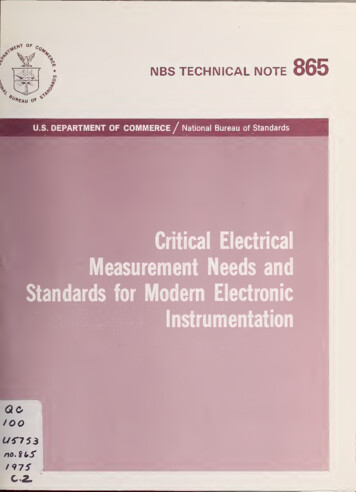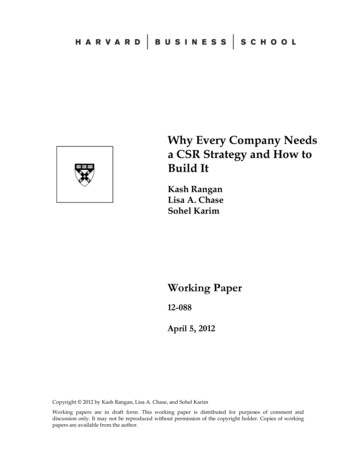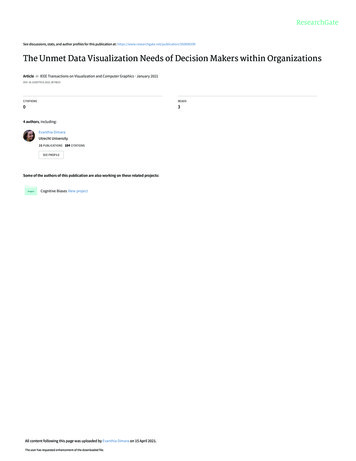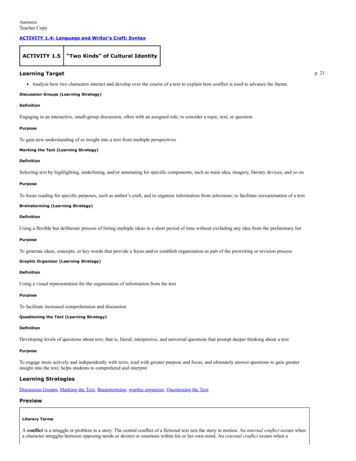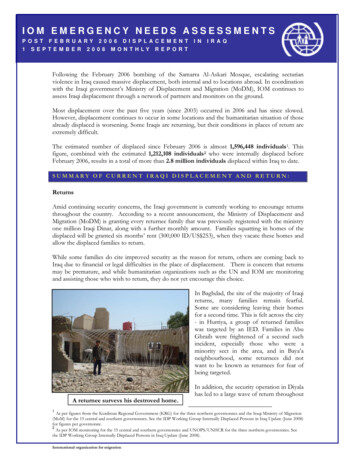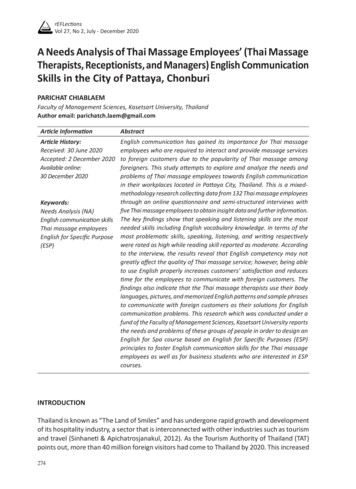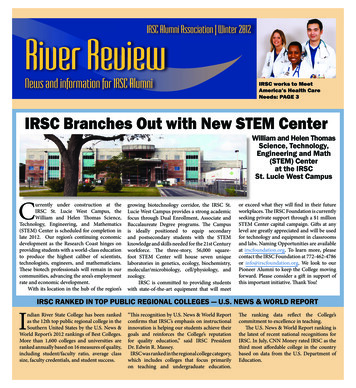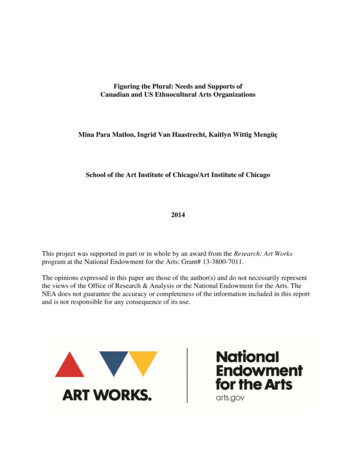
Transcription
Figuring the Plural: Needs and Supports ofCanadian and US Ethnocultural Arts OrganizationsMina Para Matlon, Ingrid Van Haastrecht, Kaitlyn Wittig MengüçSchool of the Art Institute of Chicago/Art Institute of Chicago2014This project was supported in part or in whole by an award from the Research: Art Worksprogram at the National Endowment for the Arts: Grant# 13-3800-7011.The opinions expressed in this paper are those of the author(s) and do not necessarily representthe views of the Office of Research & Analysis or the National Endowment for the Arts. TheNEA does not guarantee the accuracy or completeness of the information included in this reportand is not responsible for any consequence of its use.
FiguringthePluralWritten, edited, and compiled byMina Para MatlonIngrid Van HaastrechtKaitlyn Wittig Mengüç
2014 by PluralAll rights reserved. Published 2014.Printed in the United States of AmericaPlural (http://pluralculture.com) is a project based out of the School of the Art Institute of Chicago and dedicated to supporting Canadian andUS ethnocultural arts organizations.The Plural project co-leads gratefully acknowledge the generous support of this research project by the Joyce Foundation, National Endowment forthe Arts, and the School of the Art Institute of Chicago.Text material (excluding artwork that appears as text such as script excerpts and poems) may be reprinted without permission for any noncommercial use, provided Plural is properly credited and its copyright is acknowledged. Permission to reproduce photographs or other artwork, orthe artistic discipline profiles separate from the work as a whole, must be obtained from the copyright owner listed in the relevant credit.Cover image: Chanel Kennebrew, OVERGIVE: 28”x28” Mixed Media Painting Collage. Part of the Smile Now Die Later series. Reproduced bypermission from Chanel Kennebrew.
Figuring the PluralNeeds and Supports of Canadian and US Ethnocultural Arts OrganizationsWritten, edited, and compiled byMina Para MatlonIngrid Van HaastrechtKaitlyn Wittig Mengüç
Image 1. McIntosh County Shouters, 2011. Left: Carletha Sullivan, Carolyn Palmer, Venus McIver, and Rebecca Wahlin (Shouters);Right: Tre Stevens (Stickman), Alberta Sallins, L.C. Scott (Basers and Clappers) and Freddie Palmer (Lead Songster). Photograph byTroup Nightengale. Reproduced by permission from McIntosh County Shouters.iii
ContentsProject Team viAdvisory Committee viiiInterview Participants xAcknowledgements xivList of Figures xviExecutive Summary 2English 2French 7Spanish 13Methodology 20Terminology 36The Evolution of Arab-American Literary Arts 190by Alex AubryCharacteristics by Pan Racial Group 196Canada 197United States 208Unpacking the Crisis Narrative of Black Theater 228by Jordanna MatlonCharacteristics by Province/Region 232Canada 233United States 244Introduction 40Latino Arts Organizations in Smaller and Younger ImmigrantNeighborhoods 276by Margaret SmithPart I:Historical Background 46Canada 48United States 82Affirming and Innovating Tradition in North AmericanUkrainian Dance 280by Yaryna KlimchakPart II: Current Ethnocultural Arts Organizations (20132014) 136Indigenous Techne: Native New Media in North America 138by Leena MinifieOverview of Characteristics 148Canada 148United States 166Needs and Supports: A Life Cycle Approach 284Performing in Liminal Spaces; the Future of North AmericanTaiko 338by Kaitlyn Wittig MengüçSuggested Areas for Future Research 346Artwork in Context 348Selected Bibliography 354iv
Appendices (included separately)Appendix A: Database of Canadian ethnocultural arts organizationsAppendix B: Database of US ethnocultural arts organizationsAppendix C: Database of Canadian support organizationsAppendix D: Database of US support organizationsAppendix E: Interview questions templateAppendix F: Canadian survey questionsAppendix G: US English/Spanish survey questionsAppendices H-J: Canadian survey results by Aboriginal, Culturally Diverse, and White pan group (open-ended responses omitted to maintainprivacy of respondents)Appendices K-R: US survey results by pan-racial group (open-ended responses omitted to maintain privacy of respondents)Appendix S: Arts organization interview instructionsAppendix T: Consent and release form template: US arts organization, no transcriptAppendix U: Calculations for Survey Representativenessv
Project TeamMina Para Matlon, Founder/Project Co-LeadIngrid Van Haastrecht, Founder/Project Co-LeadKaitlyn Wittig Mengüç, Project Co-LeadAlex Aubry, Graphic Design & Contributing WriterJacqueline Chao, Media & Graphic DesignPatricia Morris Alava, Spanish Translation & Field ResearchJasmyn Grace Smith, ResearchMadeline Smith, ResearchAlda Akhsar Tchochiev, Artist Liaison & Field ResearchContributing WritersYaryna KlimchakJordanna MatlonLeena MinifieMargaret SmithRebecca Duclos, Dean of Graduate Studies at the School of the Art Institute of Chicago, is an ad hoc member of the project team.Brant Gidwitz contributed geographic visualization services.vi
Images 2 and 3. Julianne Beaudin-Herney. Inner Parts of Me (Part 1), 2013. Photos taken on iPhone by Maariu Costa, Edited by the Artist. Julianneis a member of Sâkêwêwak Artists Collective Inc. Reproduced by permission from Julianne Beaudin-Herney.vii
Advisory CommitteeCanadaMillie Knapp, Association for Native Development in the Performing and Visual ArtsSandra Laronde, Indigenous Arts at The Banff Centre; Red Sky PerformanceShahin Sayadi, OneLight Theatre & Prismatic FestivalSanjay Shahani, The Ontario Trillium FoundationCharles C. Smith, Cultural Pluralism in the Arts Movement OntarioMaggie Stewart, OneLight Theatre & Prismatic FestivalUnited StatesJennifer Armstrong, on behalf of the entire board of The Association of American CulturesRoberto Bedoya, Tucson Pima Arts CouncilDeepa Gupta, The Boeing CompanyAngelique Power, The Joyce FoundationGina Rodriguez-Drix, Rhode Island Council for the HumanitiesRebeccah Sanders, formerly of the Chicago Cultural AllianceCarlton Turner, Alternate RootsOrganizations are listed solely for identification purposesImage 4. Paloma Nuñez and Juan Carlos Velis in TheIntruder, Alameda Theatre Company, 2011. Written byAmaranta Leyva. Photograph by Steve Carty. Reproducedby permission from Alameda Theatre Company.viii
Image 5. Oinkari women perform Lapurdiko Makil Dantza during Trailing of the Sheep, an annual celebration of sheepherding cultures. OinkariBasque Dancers, 2012. Photograph by Dev Khalsa. Reproduced by permission from Oinkari Basque Dancers.ix
Interview ParticipantsCanadaAboriginal Arts, Alberta Foundation for the ArtsAboriginal Arts, Canada Council for the ArtsAccès AsieAlianait Arts Festival (Alianait Entertainment Group)Alameda Theatre CompanyAshkenaz FoundationB Current Performing ArtsCanadian Public Arts FundersCanadian Hungarian Cultural Society of EdmontonCanadian Native Friendship Centre of EdmontonCircle of Life Thunderbird HouseCollective of Black ArtistsCommunity Arts, BC Arts CouncilConstantinopleDancers of Damelahamid SocietyDebajehmujig Theatre GroupDesna Ukrainian Dance Company of TorontoDiversité Artistique Montréal (DAM)Edmonton Raga-Mala Music SocietyEmbraceBCFirst Peoples Cultural CouncilGrunt GalleryInhabit MediaJanak Khendry Dance CompanyKokoro DanceLorita Leung Dance CompanyMT SpaceMAI (Montréal, arts interculturels)NAfro Dance ProductionsNative Earth Performing ArtsNikkei National Museum & Cultural CentreNorthern Arts & Cultural CentreObsidian Theatre CompanyOnelight Theatre Society & Prismatic FestivalOntario Arts CouncilPavlychenko Folklorique EnsemblePowell Street Festival SocietyPuente Theatre SocietyRaven Spirit DanceSâkêwêwak Artists’ CollectiveSaskatchewan Native Theatre CompanyShevchenko FoundationSouth Asian Visual Arts CentreTara Players Theatre of OttawaTeesri Duniya TheatreToronto Reel Asian International Film FestivalUkrainian Cultural and Educational CentreUkrainian Shumka DancersUrban Ink ProductionsUrban ShamanUzume Taiko Drum Group SocietyVancouver Latin American Film FestivalVesnivka Women’s ChoirWinnipeg Jewish TheatreYukon Arts CentreUnited StatesAfriky LoloAktina ProductionsAkvavit TheatreAkwesasne Library and Cultural CenterAll My Relations Arts (an initiative of the NativeAmerican Community Development Institute)American Swedish InstituteAriztlan Studiosx
Arlekin Players TheatreARTEEASTAsian American Arts AllianceAsian Pacific American FilmAswan DancersAtlanta Chinese Dance CompanyBallet Hispanico of New YorkBallet Lisanga Congolese Performing Arts CompanyBlack Ensemble Theater (Chicago)Black Storytellers Alliance (Minneapolis)Borderlands TheaterBoston Jewish Music FestivalBreath of Fire Latina Theater EnsembleCalifornia Arts CouncilCarver Community Cultural CenterCenter for Arabic CultureCenter for Asian American MediaChai Latte ProductionsCHAT (Center for Hmong Arts & Talent)Cinema TropicalConsortium of Black Organizations for the ArtsCôr Cymraeg RehobothCountry Dance Society Boston CentreCreative CapitalCypreco of AmericaEast Bay Center for the Performing ArtsEdgeworks Dance TheaterEnsemble Theater (Texas)Fire This Time FestivalFirst People’s FundFirst VoiceFractured AtlasGolden Thread ProductionsH T Dance Company - Chen Dance CenterHeritage Signature ChoraleIndian Performing Arts SamskritiIndian Pueblo Cultural CenterJapanese Embroidery CenterxiKankouran West African Dance CompanyKarpatok Hungarian Folk EnsembleKearny Street WorkshopKulintang ArtsKumu Kahua TheatreLa Pena Cultural CenterLatino Arts NetworkLatino International Theater Festival of New York, Inc. – TeatroStageFestLee Young Hee Museum of Korean CultureLevantine Cultural CenterLos Cenzontles Mexican Arts CenterMcIntosh County ShoutersMECA (Multicultural Education and Counseling through the Arts)MiznaMPAACTMu Performing Arts (Theatre Mu)Mu’olaulaniMuseum at Warm SpringsNational Association of Latino Arts and CulturesNew York African Chorus EnsembleNorth American Basque OrganizationsOinkari Basque DancersPalmetto & LunaPan Asian Repertory TheatrePepatianPrograms & Partnerships, National Endowment for the ArtsScottish Partnership for Arts & EducationSelf-Help Graphics and ArtsSilk Road Rising (Gilloury Institute)South Asian Women’s Creative CollectiveStir-Friday NightTaiko Center of the PacificTeatro CirculoTeatro LunaThe Color of Film CollaborativeUkrainian Institute of Modern ArtWing Luke Museum of the Asian Pacific American Experience
Image 6. The Lake Effect, Silk Road Rising, 2013. Written by Rajiv Joseph. Left to right: Minita Gandhi, Adam Poss, and Mark Smith. Photograph byMichael Brosilow. Reproduced by permission from Alameda Theatre Company.xiii
AcknowledgementsFrom inception to completion, Plural has been a collaborative endeavor.We would particularly like to thank the following individuals andorganizations for their time, research, experiences, and hospitality:The Art Institute of Chicago and the School of the Art Instituteof Chicago, especially Professors Rachel Weiss and Adelheid Mers,Librarians Jenn Smith, Nathaniel Feis, and Holly Stec Dankert of theFlaxman Library, Dr. Pamela Jennings, former Director of the Earland Brenda Shapiro Center for Research and Collaboration, BrianEsker, Devin Henderson, Helema Lewis, Shirley Rucker, and DannyUrbina-McCarthy of Accounting-Fiscal Office-SAIC, Patricia Moccoof Accounting, Ingrid Parker of Institutional Advancement, MichalLynn Shumate of the Dean’s Office, Rashayla Marie Brown of StudentAffairs for Diversity and Inclusion, and Maureen Ryan of the President& Director’s Office, Art Institute of Chicago; our Advisory Committee;the American Indian Center of Chicago, the Balzekas Museum ofLithuanian Culture, Luna Negra, and Natya Dance Theatre, whoserved as our survey pilot participants; our survey participants; ourformal interview participants, who are listed on the preceding pages;the Joyce Foundation with particular gratitude to Angelique Power, whofound wings for a vision; the National Endowment for the Arts, especiallyPatrice Walker Powell, Barry Bergey, and Sunil Iyengar; the CanadaCouncil for the Arts, especially Jacinthe Soulliere, Sheila James, VanessaNovack, Jeffrey Morrow, and Ellen Busby; the Department of CanadianHeritage, especially Martin Durand and Glenn Morrison; A.B. Spellman;the California Arts Council, especially Lucero Arellano (now retired) andCaitlin Fitzwater; Vanessa Whang of Cal Humanities; Geoffrey Gurdof Aboriginal Affairs and Northern Development Canada’s CulturalEducational Centres Program; Sonya Thompson of the Research,Planning, and Policy division of the Alberta Foundation for the Arts;Amy Kitchener of the Alliance for California Traditional Arts; FlanneryPatton; Carla Roberts, former Executive Director of Atlatl; Philip Katz;Timothy Lloyd of the American Folklore Society; Amanda Alef and BenDavidson of Americans for the Arts; Nico Daswani, former ProgramDirector for the Asian American Arts Alliance; Arts Alliance Illinois;Bonnie Devine of the Ontario College of Art and Design; James Britt;Jerry Yoshitomi; Alain Pineau of the now closed Canadian Conferenceof the Arts; the Canadian Ethnocultural Council; Dr. Marta MorenoVega of the Caribbean Cultural Center; Cecilia Garibay; the Center forArts and Cultural Policy Studies at Princeton University; Dr. Alaka Waliof the Center for Cultural Understanding at the Field Museum; WillAnderson of the University of Chicago’s Cultural Policy Center; Dr.Allan J. Ryan of Carleton University; Dr. Carole Rosenstein of GeorgeMason University; Dr. Elizabeth Peterson of the American FolklifeCenter; Dr. Francie Ostrower of UT-Austin; Dr. Kristin Dowell of theUniversity of Oklahoma; Eduardo Diaz of the Smithsonian LatinoCenter; Claudette Commanda of the First Nations Confederacy ofCultural Education Centres; the First Nations Development Institute; theFlorida Division of Cultural Affairs; Tommer Peterson of Grantmakersin the Arts; Holly Sidford; Alex Winston Jeffers; Mario Nick Klimiadesof Library and Archives at the Heard Museum; Michele Sereda ofCurtain Razors; Yuriko Iga of Blim; William McCullough; Jason Tsengof Community Engagement at Fractured Atlas; the Mid Atlantic ArtsFoundation; Belinda Rawlins of NAMAC; the National Arts Centre; theNational Assembly of State Arts Agencies, especially Ryan Stubbs; theNational Association of Latino Arts and Cultures; the National Centerfor Charitable Statistics; the National Council for the Traditional Arts;the National Endowment for the Humanities; the Neighborhood ArtsNetwork, especially former Coordinator Skye Louis; Susan Peirez of theNew York State Council on the Arts; Kimber Craine of the President’sCommittee on the Arts and Humanities; Kathryn Townshend ofResearch, Policy and Evaluation at the Ontario Arts Council; theReybet-Degat family; San San Wong of the Barr Foundation; Sarah Leeof Slover Linett; the South Carolina Arts Commission, especially SaraJune Goldstein; Adam Tarnoff; Shannon Farley; Salvador Acevedo;Statistics Canada; James Early of the Smithsonian Center for Folklifeand Cultural Heritage; Jim Bob McMillan of the Texas Commission onthe Arts; Theaster Gates; The Association for Canadian Studies; LucieD’Aoust of The Cultural Human Resources Council; Reina Mukai ofxiv
the Foundation Center; the Toronto Arts Council; Eugene Boulangerof W2/Vancouver Indigenous Media Arts Festival; Dr. Ann Stone ofthe Wallace Foundation; Dr. Maria Rosario Jackson; Christon NicholeHerring; W. Cecyl Hobbs; Warren Garrett of CCI – Ontario PresentingNetwork; and the Western States Arts Federation.This project further owes debts of gratitude to Elinor Bowles,the author of Cultural Centers of Color, and Louise Poulin, the author ofStories from the Field: Perspectives on Innovative Management Practices for Aboriginaland Culturally Diverse Arts Organizations, each of whom ensured that thepioneering work of our cultural leaders would be remembered andcelebrated. We are also tremendously grateful for our families, whosegeneral observation throughout this process has been, “it may be a littletoo ambitious,” but who nonetheless worked in the trenches with uswhenever we needed additional help.In Letters to a Young Artist, actress and playwright Anna DeavereSmith recalls the words of intellectual and activist Cornel West indescribing the role of the artist in society. “‘Hope,’” she says, quotingWest, “‘calls for a leap of faith that goes beyond the evidence to create newpossibilities based on visions that become contagious. These visions allowpeople to engage in heroic actions, always against the odds, no guaranteewhatsoever.’” Artists provide us with these visions, but as Deavere Smithnotes, those who work in the cultural sector are often undervalued inpart because “there is no guarantee that [art] will help make test scoresor anything else any better.” The value of art, however, lies less in itsability to create certainty, and more in its ability to expand possibilityand help us navigate complexity. Nowhere is the potential impact ofart greater than when wielded by our ethnocultural arts organizations,whose work connects us to who we were, promotes full participation inunderstanding and shaping who we are, and offers us visions and actionstoward a more just and pluralistic society – who we may become. Visionsand actions that are contagious. This book is dedicated to them.xv
List of FiguresSet forth below is a list of all the graphs, maps, and tables in the orderthat these figures appear in Part II.Figure 11. Dedicated arts services accessed by Canadian surveyrespondents (2011-2013) 154Figure 1. Canadian organizations by artistic discipline 149Figure 12. Constraints in accessing arts services by Canadian surveyrespondent ranking 154Figure 2. Canadian organizations by CRA effective year of status 149Figure 3. Canadian survey respondents by number of paid employees150Table 1. Average and median annual revenue for arts and cultureorganizations in Canada (2012-2013) 150Figure 4. Canadian organizations by average annual gross income:frequency distribution (2010-2012) 151Figure 5. Canadian organizations by median annual gross income peryear (2010-2012) 151Figure 13. Funding sources supporting Canadian survey respondents(2011-2013) 155Figure 14. Dedicated funding programs accessed by Canadian surveyrespondents 155Figure 15. Types of collaborating organizations of Canadian surveyrespondents 156Figure 16. Constraints to collaboration by Canadian survey respondentranking 157Figure 17. Canadian arts service organizations by services provided 165Figure 6. Canadian survey respondents by income sources 152Figure 18. US organizations by artistic discipline 166Figure 7. Organizational challenges by Canadian survey respondentranking (General) 152Figure 8. Financial resource needs by Canadian survey respondentranking 153Figure 9. Capacity building needs by Canadian survey respondentranking 153Figure 10. Arts services accessed by Canadian survey respondents (20112013) 154Figure 19. US organizations by decade founded 166Figure 20. US survey respondents by number of paid employees 167Figure 21. US survey respondents by number of paid employees andoperating budget 168Figure 22. US organizations by average annual gross income: frequencydistribution (2009-2012) 169xvi
Figure 23. US organizations by median annual gross income per year(2009-2012) 169Figure 35. US arts service organizations by services provided 182Figure 36. Canadian organizations by pan group 197Figure 24. US survey respondents by income sources 170Figure 25. Organizational challenges by US survey respondent ranking(General) 170Figure 26. Financial resource needs by US survey respondent ranking171Figure 27. Capacity building needs by US survey respondent ranking171Figure 28. Arts services accessed by US survey respondents (2011-2013)172Figure 29. Dedicated arts services accessed by US survey respondents(2011-2013) 173Figure 30. Constraints in accessing arts services by US survey responde
The Art Institute of Chicago and the School of the Art Institute of Chicago, especially Professors Rachel Weiss and Adelheid Mers, . Jennings, former Director of the Earl and Brenda Shapiro Center for Research and Collaboration, Brian Esker, Devin Henderson, Helema Lewis, Shirley Rucker,
